City Of Sais: Prehistoric Prestigious Cult Center Of Northern Egypt
A. Sutherland - AncientPages.com - Millennia ago, a beautiful Egyptian city existed in the western Egyptian delta along the Rosetta branch of the Nile River. Its name was ‘Sa’, known from its Greek name: ‘Sais’ (Saïs).
History of Sais goes back to Egypt’s pre-dynastic times (prior to 3100 BC) but the only visible ruins are not older than the 11th century. At the ancient site, there is now a village of Sa al-Hagar (‘Sa - means stone’ in Arabic). There are today no surviving traces of this town prior to the Late New Kingdom (c.1100 BC)
 According to Herodotus and some other sources, Sais was a prestigious cult center of northern Egypt about 3100 BC, full of great and luxurious buildings and royal sepulchers.
According to Herodotus and some other sources, Sais was a prestigious cult center of northern Egypt about 3100 BC, full of great and luxurious buildings and royal sepulchers.
The city suffered damage at the hands of Cambyses, who four years after ascending the throne, marched against Egypt, where he ruined the tomb of Amasis (also known as Ahmose II, which means "The Moon is Born, Son of Neith").
Amasis was probably the 5th ruler of Egypt during the 26th Dynasty and has been called the last great Egyptian Pharaoh. He ruled 44 years and made many contributions to the country.
He established himself at Sais in Northern Egypt and there – like in many other places in Egypt – he ordered to build huge buildings including his tomb at Sais, which was unfortunately never discovered, but according to Herodotus’ description was beautiful:
‘It is a great cloistered building of stone, decorated with pillars carved in the imitation of palm-trees, and other costly ornaments. Within the cloister is a chamber with double doors, and behind the doors stands the sepulchre…"
In the age of the Ptolemies (B.C. 323 to 30), Sais was an important center.
Ancient Sais was the center of the cult of the goddess of war and hunting, Neith, who was the patron goddess of Sais, a great protector of the people of the land and the most accomplished mediator between humanity and the gods. From the Late Period (1000 BC onwards), the Neith temple was a center of pilgrimage.
See also:
Sobek – Enigmatic Crocodile God Of Ancient Egypt
Who Was King Menes? Mystery Of This Legendary Ruler May Go Back 20,000 Years
Unusual Double Temple Of Kom Ombo Dedicated To Crocodile God Sobek And Falcon-Headed God Horus
However, Sais had several other temples dedicated to the creator god Atum and one dedicated to the Egyptian Lord of the Underworld and Judge of the Dead, Osiris. According to Herodotus, the grave of Osiris was located at Sais and that the sufferings of this god were displayed as a mystery by night on a neighboring lake.
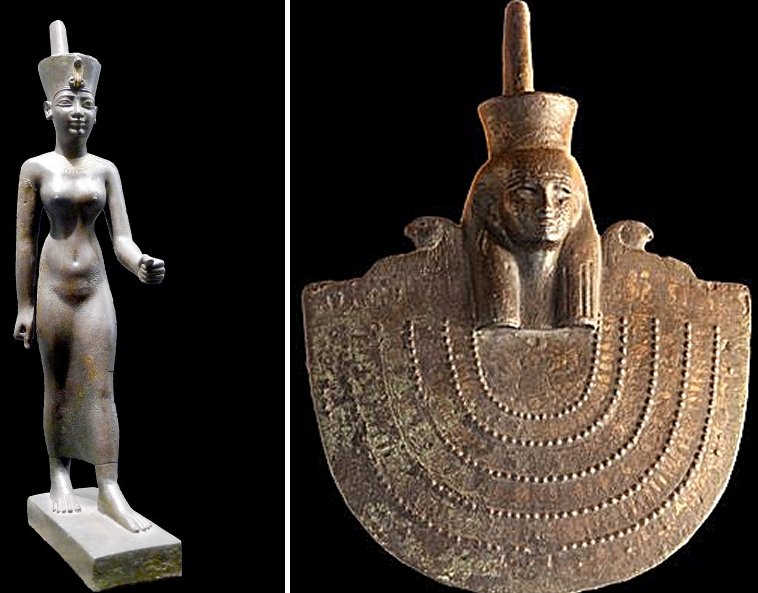
Left: A gilded bronze statuette of the Egyptian goddess of war Neith. 664-332 BCE. (Louvre, Paris); Right: Goddess Neith, the Egyptian goddess of war. Gilded bronze, XXVI Dynasty, c. 664-525 BCE. Museum of Fine Arts, Lyon, France
The Temple of Sais had a medical school associated with it and the medical school at Sais had many female students and apparently women faculty as well, mainly in gynecology and obstetrics.
An inscription from the period survives at Sais, and reads,
"I have come from the school of medicine at Heliopolis, and have studied at the woman's school at Sais, where the divine mothers have taught me how to cure diseases…".
Many kings of Sais were clever men and among them was King Nekau of the Twenty-sixth Dynasty (ruled 15 years) who despatched an expedition that circumnavigated Africa, and he was the king who started the construction of a canal from the Nile to the Red Sea, completed by the Achaemenid king Darius I.
Another ruler of Sais was Psamtek (Psammetichus III) son of Amasis, who was considered Persia's constant enemy. The Persians invaded Egypt in 525 BC just after Psamtek III became king.
The Sais’ fate is not exactly known but it is known by the Persian king Cambyses destroyed much on his way including several temples at Sais.
Written by A. Sutherland - AncientPages.com Staff Writer
Copyright © AncientPages.com All rights reserved. This material may not be published, broadcast, rewritten or redistributed in whole or part without the express written permission of AncientPages.com
Expand for referencesMore From Ancient Pages
-
 Unique Steelyard Discovery Sheds Light On Life At Milecastle 46
Archaeology | Aug 4, 2023
Unique Steelyard Discovery Sheds Light On Life At Milecastle 46
Archaeology | Aug 4, 2023 -
 Gorgo – Queen Of Sparta And Wife Of King Leonidas Broke A Secret Code And Stopped An Invasion
Featured Stories | Aug 5, 2019
Gorgo – Queen Of Sparta And Wife Of King Leonidas Broke A Secret Code And Stopped An Invasion
Featured Stories | Aug 5, 2019 -
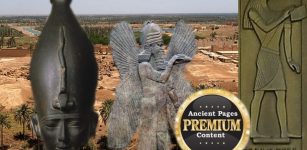 Surprising Ancient Secrets Of The ‘Second Thoth’ And God Osiris
Egyptian Mythology | Sep 27, 2018
Surprising Ancient Secrets Of The ‘Second Thoth’ And God Osiris
Egyptian Mythology | Sep 27, 2018 -
 Legend Of Milky Way’s Celestial Portal And The Star City From The Bowuzhi By Zhang Hua
Chinese Mythology | Feb 14, 2024
Legend Of Milky Way’s Celestial Portal And The Star City From The Bowuzhi By Zhang Hua
Chinese Mythology | Feb 14, 2024 -
 Kingdom Of The Vandals: A People In Search Of A Home
Civilizations | Dec 14, 2018
Kingdom Of The Vandals: A People In Search Of A Home
Civilizations | Dec 14, 2018 -
 Mystery Of Ancient, Overlooked Calico: Early Man Site In The Mojave Desert Of North America
Civilizations | Sep 9, 2021
Mystery Of Ancient, Overlooked Calico: Early Man Site In The Mojave Desert Of North America
Civilizations | Sep 9, 2021 -
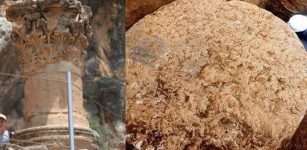 Massive Roman-Era Column Base Of Limestone Unearthed In The Foothills Of Mount Hermon, Golan Heights
Archaeology | Oct 29, 2022
Massive Roman-Era Column Base Of Limestone Unearthed In The Foothills Of Mount Hermon, Golan Heights
Archaeology | Oct 29, 2022 -
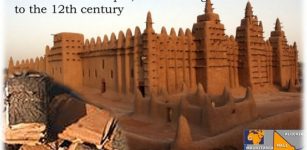 Ancient Manuscripts Of Mythical City Of Timbuktu
Artifacts | Jun 12, 2014
Ancient Manuscripts Of Mythical City Of Timbuktu
Artifacts | Jun 12, 2014 -
 Mystery Of The Ancient Reptilian Gods Remains A Complex Subject – Memories Of The Past – Part 1
Featured Stories | Feb 6, 2022
Mystery Of The Ancient Reptilian Gods Remains A Complex Subject – Memories Of The Past – Part 1
Featured Stories | Feb 6, 2022 -
 The Ancient ‘Flying Machines’ Of Icarus and Daedalus
Featured Stories | Aug 16, 2014
The Ancient ‘Flying Machines’ Of Icarus and Daedalus
Featured Stories | Aug 16, 2014 -
 Huge Lost Ancient Underground City Of Samen Finally Reveals Its Secrets
Archaeology | Apr 28, 2017
Huge Lost Ancient Underground City Of Samen Finally Reveals Its Secrets
Archaeology | Apr 28, 2017 -
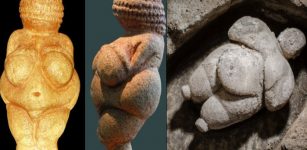 ‘Venus of Willendorf’: New Theory On ‘Venus’ Figurines – Proposed
Artifacts | Dec 1, 2020
‘Venus of Willendorf’: New Theory On ‘Venus’ Figurines – Proposed
Artifacts | Dec 1, 2020 -
 On This Day In History: 4000 Defenders Of Pilėnai Commit Mass Suicide When Attacked By Teutonic Knights – On Feb 25, 1336
News | Feb 25, 2017
On This Day In History: 4000 Defenders Of Pilėnai Commit Mass Suicide When Attacked By Teutonic Knights – On Feb 25, 1336
News | Feb 25, 2017 -
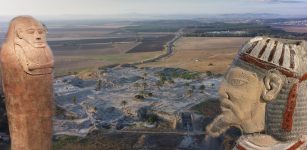 Ancient Mystery Of The Biblical Canaanites – New DNA Insight
Archaeology | May 28, 2020
Ancient Mystery Of The Biblical Canaanites – New DNA Insight
Archaeology | May 28, 2020 -
 ‘King Arthur’s Hall’ Is 4,000 Years Older Than Previously Thought
Archaeology | Nov 12, 2024
‘King Arthur’s Hall’ Is 4,000 Years Older Than Previously Thought
Archaeology | Nov 12, 2024 -
 Who Deceived Mighty Yuku God Of Rain And Thunder In Beliefs Of Yaquis Of Southern Arizona And Sonora, Mexico?
Native American Mythology | Dec 21, 2023
Who Deceived Mighty Yuku God Of Rain And Thunder In Beliefs Of Yaquis Of Southern Arizona And Sonora, Mexico?
Native American Mythology | Dec 21, 2023 -
 Vikings: Facts And History About The Tough Norse Seafaring People
Ancient History Facts | Mar 13, 2017
Vikings: Facts And History About The Tough Norse Seafaring People
Ancient History Facts | Mar 13, 2017 -
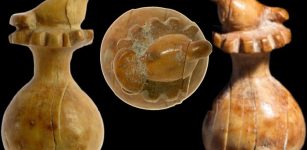 The Dove And The Pomegranate: Who Was The High-Ranking Lady Who Owned This Unique Artifact In The First Temple Period?
Artifacts | Aug 9, 2023
The Dove And The Pomegranate: Who Was The High-Ranking Lady Who Owned This Unique Artifact In The First Temple Period?
Artifacts | Aug 9, 2023 -
 Gargoyles – Mysterious Ancient Fearsome Creatures Warding Off Evil
Featured Stories | Nov 25, 2024
Gargoyles – Mysterious Ancient Fearsome Creatures Warding Off Evil
Featured Stories | Nov 25, 2024 -
 Climate In The Andes Has Driven 7,000 Years Of Dietary Changes – New Study Reveals
Archaeology | Feb 9, 2022
Climate In The Andes Has Driven 7,000 Years Of Dietary Changes – New Study Reveals
Archaeology | Feb 9, 2022


